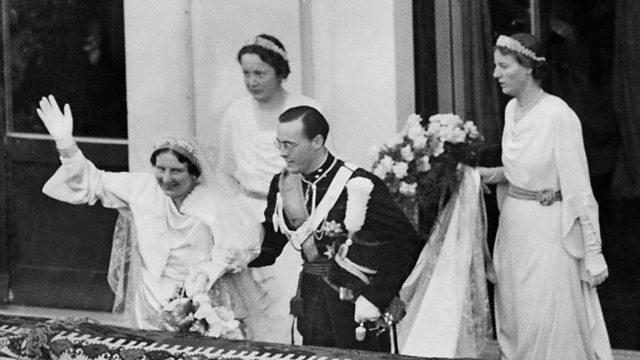
6 mei 2015
Prince Bernhard began to make himself popular in the eyes of the Dutch people at the outset of World War II. During the German Invasion, the Prince, carrying a machine gun, allegedly organised the palace guards into a combat group and shot at German planes. The Royal Family fled the Netherlands and took refuge in England. In disagreement with Queen Wilhelmina’s decision to leave the Kingdom, the young Prince Consort, aged 28, is said to have refused to go initially and wanted to oppose the Nazi occupation from within its borders, but eventually agreed to join her as head of the Royal Military Mission based in London. Once safely there, his wife Princess Juliana and their children went on to Canada, where they remained until the end of the war.
In England, Prince Bernhard asked to work in British Intelligence but the War Admiralty, and later General Eisenhower’s Allied Command offices, did not trust him sufficiently to allow him access to sensitive intelligence information. However, on the recommendation of Bernhard’s friend and admirer, King George VI, who was also of German aristocratic descent via his great-grandfather Prince Albert of Saxe-Coburg and Gotha, and after being personally screened by intelligence officer Ian Fleming at the behest of Churchill, he was later permitted to work in the Allied War Planning Councils.
“For Bernhard, the Prince of the Netherlands, the war was a frustrating business. Born a German, he had married Queen Wilhelmina’s only child, Princess Juliana, and in due time made a conscious and meaningful transition of loyalties to his new homeland. Because of this, and in view of the doubts his background initially evoked among some Britons, he longed more than anyone for a chance to get at Holland’s aggressors.” Erik Hazelhoff Roelfzema aka Soldier of Orange, decorated war hero.
On 25 June 1940, three days after France fell to the German war machine, Bernhard spoke on the Overseas Service of the BBC, calling Hitler a German tyrant and expressing his confidence that Great Britain would defeat the Third Reich.
In 1940, Flight Lieutenant Murray Payne gave the Prince instruction in flying a Spitfire. The Prince made 1,000 flight-hours in a Spitfire with the RAF’s 322 “Dutch” Squadron, wrecking two planes during landings. He remained an active pilot throughout his life and flew his last airplane 53 years later, with his grandson and heir to the throne, who inherited his passion for flying.
In 1941, Prince Bernhard was given the honorary rank of Wing Commander in the Royal Air Force. As “Wing Commander Gibbs (RAF)”, Prince Bernhard flew over occupied Europe, attacking V-1 launch pads in a B-24 Liberator, bombing Pisa and engaging submarines over the Atlantic in a B-25 Mitchell and conducting reconnaissance over enemy-held territory in an L-5 Grasshopper. Prince Bernhard was awarded the Dutch Airman’s Cross for his “ability and perseverance” (Dutch: “bekwaamheid en volharding”).
He also helped organise the Dutch resistance movement and acted as personal secretary for Queen Wilhelmina.
Queen Wilhelmina erased the style “honorary” (the exact words were “à la suite”) in the decree promoting Bernhard to General. In this unconstitutional manner, she gave this Royal Prince a status that was never intended by either Parliament or her Ministers. The Minister of Defence did not choose to correct the Monarch and the Prince took an active and important role in the Dutch Armed forces.
By 1944, Prince Bernhard became Commander of the Dutch Armed Forces. After the liberation of the Netherlands, he returned with his family and became active in the negotiations for the German surrender. He was present during the Armistice negotiations and German surrender at Hotel de Wereld (“The World Hotel”), Wageningen in The Netherlands on 5 May 1945, where he avoided speaking German. The Prince was a genuine war hero in the eyes of most of the Dutch and even kept cordial relations with the Communists who fought against the Nazis. In the post-war years he earned respect for his work in helping to reinvigorate the economy of the Netherlands.

